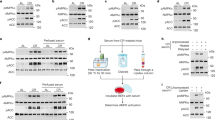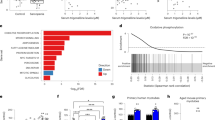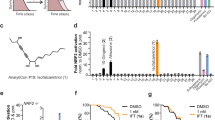Abstract
The biological effects of urolithins remain poorly characterized, despite wide-spread human exposure via the dietary consumption of their metabolic precursors, the ellagitannins, which are found in the pomegranate fruit, as well as in nuts and berries. We identified urolithin A (UA) as a first-in-class natural compound that induces mitophagy both in vitro and in vivo following oral consumption. In C. elegans, UA prevented the accumulation of dysfunctional mitochondria with age and extended lifespan. Likewise, UA prolonged normal activity during aging in C. elegans, including mobility and pharyngeal pumping, while maintaining mitochondrial respiratory capacity. These effects translated to rodents, where UA improved exercise capacity in two different mouse models of age-related decline of muscle function, as well as in young rats. Our findings highlight the health benefits of urolithin A and its potential application in strategies to improve mitochondrial and muscle function.
This is a preview of subscription content, access via your institution
Access options
Subscribe to this journal
Receive 12 print issues and online access
We are sorry, but there is no personal subscription option available for your country.
Buy this article
- Purchase on SpringerLink
- Instant access to full article PDF
Prices may be subject to local taxes which are calculated during checkout






Similar content being viewed by others
References
Cordain, L. et al. Plant–animal subsistence ratios and macronutrient energy estimations in worldwide hunter-gatherer diets. Am. J. Clin. Nutr. 71, 682–692 (2000).
Bakkalbas¸i, E., Mentes¸, O. & Artik, N. Food ellagitannins—occurrence, effects of processing and storage. Crit. Rev. Food Sci. Nutr. 49, 283–298 (2009).
Johanningsmeier, S.D. & Harris, G.K. Pomegranate as a functional food and nutraceutical source. Annu. Rev. Food Sci. Technol. 2, 181–201 (2011).
Espín, J.C., Larrosa, M., García-Conesa, M.T. & Tomás-Barberán, F. Biological significance of urolithins, the gut microbial ellagic acid–derived metabolites: the evidence so far. Evid. Based Complement. Alternat. Med. 2013, 270418 (2013).
Seeram, N.P. et al. Pomegranate juice ellagitannin metabolites are present in human plasma and some persist in urine for up to 48 hours. J. Nutr. 136, 2481–2485 (2006).
Nuñez-Sánchez, M.A. et al. _targeted metabolic profiling of pomegranate polyphenols and urolithins in plasma, urine and colon tissues from colorectal cancer patients. Mol. Nutr. Food Res. 58, 1199–1211 (2014).
Truchado, P. et al. Strawberry processing does not affect the production and urinary excretion of urolithins, ellagic acid metabolites, in humans. J. Agric. Food Chem. 60, 5749–5754 (2012).
González-Sarrías, A. et al. Occurrence of urolithins, gut microbiota ellagic acid metabolites and proliferation markers expression response in the human prostate gland upon consumption of walnuts and pomegranate juice. Mol. Nutr. Food Res. 54, 311–322 (2010).
Tomás-Barberán, F.A., García-Villalba, R., González-Sarrías, A., Selma, M.V. & Espín, J.C. Ellagic acid metabolism by human gut microbiota: consistent observation of three urolithin phenotypes in intervention trials, independent of food source, age and health status. J. Agric. Food Chem. 62, 6535–6538 (2014).
Seeram, N.P. et al. Pomegranate ellagitannin-derived metabolites inhibit prostate cancer growth and localize to the mouse prostate gland. J. Agric. Food Chem. 55, 7732–7737 (2007).
Piwowarski, J.P., Kiss, A.K., Granica, S. & Moeslinger, T. Urolithins, gut microbiota-derived metabolites of ellagitannins, inhibit LPS-induced inflammation in RAW 264.7 murine macrophages. Mol. Nutr. Food Res. 59, 2168–2177 (2015).
Kang, I., Kim, Y., Tomás-Barberán, F.A., Espín, J.C. & Chung, S. Urolithin A, C and D, but not iso-urolithin A and urolithin B, attenuate triglyceride accumulation in human cultures of adipocytes and hepatocytes. Mol. Nutr. Food Res. 60, 1129–1138 (2016).
Kenyon, C.J. The genetics of aging. Nature 464, 504–512 (2010).
Cabreiro, F. et al. Metformin retards aging in C. elegans by altering microbial folate and methionine metabolism. Cell 153, 228–239 (2013).
Wilkinson, D.S., Taylor, R.C. & Dillin, A. Analysis of aging in Caenorhabditis elegans. Methods Cell Biol. 107, 353–381 (2012).
Kenyon, C., Chang, J., Gensch, E., Rudner, A. & Tabtiang, R. A C. elegans mutant that lives twice as long as wild type. Nature 366, 461–464 (1993).
Lakowski, B. & Hekimi, S. The genetics of caloric restriction in Caenorhabditis elegans. Proc. Natl. Acad. Sci. USA 95, 13091–13096 (1998).
Dillin, A. et al. Rates of behavior and aging specified by mitochondrial function during development. Science 298, 2398–2401 (2002).
Lin, K., Dorman, J.B., Rodan, A. & Kenyon, C. daf-16: an HNF-3/forkhead family member that can function to double the life-span of Caenorhabditis elegans. Science 278, 1319–1322 (1997).
Apfeld, J., O'Connor, G., McDonagh, T., DiStefano, P.S. & Curtis, R. The AMP-activated protein kinase AAK-2 links energy levels and insulin-like signals to lifespan in C. elegans. Genes Dev. 18, 3004–3009 (2004).
Ishii, N. et al. A mutation in succinate dehydrogenase cytochrome b causes oxidative stress and aging in nematodes. Nature 394, 694–697 (1998).
Kang, C., You, Y.J. & Avery, L. Dual roles of autophagy in the survival of Caenorhabditis elegans during starvation. Genes Dev. 21, 2161–2171 (2007).
Hansen, M. et al. A role for autophagy in the extension of lifespan by dietary restriction in C. elegans. PLoS Genet. 4, e24 (2008).
Meléndez, A. et al. Autophagy genes are essential for dauer development and life-span extension in C. elegans. Science 301, 1387–1391 (2003).
Palikaras, K., Lionaki, E. & Tavernarakis, N. Coordination of mitophagy and mitochondrial biogenesis during aging in C. elegans. Nature 521, 525–528 (2015).
Chan, D.C. Fusion and fission: interlinked processes critical for mitochondrial health. Annu. Rev. Genet. 46, 265–287 (2012).
Lackner, L.L. & Nunnari, J. Small-molecule inhibitors of mitochondrial division: tools that translate basic biological research into medicine. Chem. Biol. 17, 578–583 (2010).
Kirienko, N.V., Ausubel, F.M. & Ruvkun, G. Mitophagy confers resistance to siderophore-mediated killing by Pseudomonas aeruginosa. Proc. Natl. Acad. Sci. USA 112, 1821–1826 (2015).
Yang, Z. & Klionsky, D.J. Eaten alive: a history of macroautophagy. Nat. Cell Biol. 12, 814–822 (2010).
Guo, S. et al. A rapid and high content assay that measures cyto-ID-stained autophagic compartments and estimates autophagy flux with potential clinical applications. Autophagy 11, 560–572 (2015).
Mizushima, N., Yoshimori, T. & Levine, B. Methods in mammalian autophagy research. Cell 140, 313–326 (2010).
Lazarou, M. et al. The ubiquitin kinase PINK1 recruits autophagy receptors to induce mitophagy. Nature 524, 309–314 (2015).
Tantama, M., Hung, Y.P. & Yellen, G. Imaging intracellular pH in live cells with a genetically encoded red fluorescent protein sensor. J. Am. Chem. Soc. 133, 10034–10037 (2011).
Youle, R.J. & Narendra, D.P. Mechanisms of mitophagy. Nat. Rev. Mol. Cell Biol. 12, 9–14 (2011).
Gasperotti, M. et al. Fate of microbial metabolites of dietary polyphenols in rats: is the brain their _target destination? ACS Chem. Neurosci. 6, 1341–1352 (2015).
Kirkin, V., McEwan, D.G., Novak, I. & Dikic, I. A role for ubiquitin in selective autophagy. Mol. Cell 34, 259–269 (2009).
Lee, J.Y., Nagano, Y., Taylor, J.P., Lim, K.L. & Yao, T.P. Disease-causing mutations in parkin impair mitochondrial ubiquitination, aggregation and HDAC6-dependent mitophagy. J. Cell Biol. 189, 671–679 (2010).
Bingol, B. et al. The mitochondrial deubiquitinase USP30 opposes parkin-mediated mitophagy. Nature 510, 370–375 (2014).
Bratic, A. & Larsson, N.G. The role of mitochondria in aging. J. Clin. Invest. 123, 951–957 (2013).
Rubinsztein, D.C., Mariño, G. & Kroemer, G. Autophagy and aging. Cell 146, 682–695 (2011).
Andreux, P.A., Houtkooper, R.H. & Auwerx, J. Pharmacological approaches to restore mitochondrial function. Nat. Rev. Drug Discov. 12, 465–483 (2013).
Gong, G. et al. Parkin-mediated mitophagy directs perinatal cardiac metabolic maturation in mice. Science 350, aad2459 (2015).
Center for Drug Evaluation and Research. Guidance for industry: estimating the maximum safe starting dose in initial clinical trials for therapeutics in adult healthy volunteers. Food and Drug Administration http://www.fda.gov/downloads/Drugs/.../Guidances/UCM078932.pdf (2005).
Perry, R.J., Zhang, D., Zhang, X.M., Boyer, J.L. & Shulman, G.I. Controlled-release mitochondrial protonophore reverses diabetes and steatohepatitis in rats. Science 347, 1253–1256 (2015).
Tao, H., Zhang, Y., Zeng, X., Shulman, G.I. & Jin, S. Niclosamide ethanolamine–induced mild mitochondrial uncoupling improves diabetic symptoms in mice. Nat. Med. 20, 1263–1269 (2014).
Perry, R.J. et al. Reversal of hypertriglyceridemia, fatty liver disease and insulin resistance by a liver-_targeted mitochondrial uncoupler. Cell Metab. 18, 740–748 (2013).
Fried, L.P. et al. Frailty in older adults: evidence for a phenotype. J. Gerontol. A Biol. Sci. Med. Sci. 56, M146–M156 (2001).
Drummond, M.J. et al. Downregulation of E3 ubiquitin ligases and mitophagy-related genes in skeletal muscle of physically inactive, frail older women: a cross-sectional comparison. J. Gerontol. A Biol. Sci. Med. Sci. 69, 1040–1048 (2014).
Robinson, S., Cooper, C. & Aihie Sayer, A. Nutrition and sarcopenia: a review of the evidence and implications for preventive strategies. J. Aging Res. 2012, 510801 (2012).
Amato, A.A. et al. Treatment of sporadic inclusion body myositis with bimagrumab. Neurology 83, 2239–2246 (2014).
Xu, Z.R., Tan, Z.J., Zhang, Q., Gui, Q.F. & Yang, Y.M. Clinical effectiveness of protein and amino acid supplementation on building muscle mass in elderly people: a meta-analysis. PLoS One 9, e109141 (2014).
Garber, K. No longer going to waste. Nat. Biotechnol. 34, 458–461 (2016).
Kim, S.J. et al. CRIF1 is essential for the synthesis and insertion of oxidative phosphorylation polypeptides in the mammalian mitochondrial membrane. Cell Metab. 16, 274–283 (2012).
Greber, B.J. et al. Architecture of the large subunit of the mammalian mitochondrial ribosome. Nature 505, 515–519 (2014).
Kamath, R.S., Martinez-Campos, M., Zipperlen, P., Fraser, A.G. & Ahringer, J. Effectiveness of specific RNA-mediated interference through ingested double-stranded RNA in Caenorhabditis elegans. Genome Biol. 2, H0002 (2001).
Mouchiroud, L. et al. Pyruvate imbalance mediates metabolic reprogramming and mimics lifespan extension by dietary restriction in Caenorhabditis elegans. Aging Cell 10, 39–54 (2011).
Mouchiroud, L. et al. The NAD+/sirtuin pathway modulates longevity through activation of mitochondrial UPR and FOXO signaling. Cell 154, 430–441 (2013).
Houtkooper, R.H. et al. Mitonuclear protein imbalance as a conserved longevity mechanism. Nature 497, 451–457 (2013).
Frezza, C., Cipolat, S. & Scorrano, L. Organelle isolation: functional mitochondria from mouse liver, muscle and cultured fibroblasts. Nat. Protoc. 2, 287–295 (2007).
Bratic, I., Hench, J. & Trifunovic, A. Caenorhabditis elegans as a model system for mtDNA replication defects. Methods 51, 437–443 (2010).
Jha, P., Wang, X. & Auwerx, J. Analysis of mitochondrial respiratory chain supercomplexes using blue native polyacrylamide gel electrophoresis (BN-PAGE). Curr. Protoc. Mouse Biol. 6, 1–14 (2016).
Vidal, K., Grosjean, I., evillard, J.P., Gespach, C. & Kaiserlian, D. Immortalization of mouse intestinal epithelial cells by the SV40-large T gene. Phenotypic and immune characterization of the MODE-K cell line. J. Immunol. Methods 166, 63–73 (1993).
Yamamoto, H. et al. NCoR1 is a conserved physiological modulator of muscle mass and oxidative function. Cell 147, 827–839 (2011).
Acknowledgements
We thank P. Gönczy (Swiss Institute for Experimental Cancer Research, Ecole Polytechnique Fédérale de Lausanne) for sharing reagents and equipment, the Caenorhabditis Genetics Center for providing worm strains and the Auwerx team members for discussions. We thank the team of the Phenotyping Unit, Center of PhenoGenomics, School of Life Sciences, Ecole Polytechnique Fédérale de Lausanne (EPFL) for their technical and scientific expertise in the mouse experiments. We thank K.H. Kim (Yonsei University College of Medicine) for providing mRFP-GFP-LC3B reporter and for discussion. We thank G. Yellen (Department of Neurobiology, Harvard Medical School) for providing mitochondrial pHRed-expressing plasmid and D. Kaiserlian (INSERM) for the Mode-K cell line. J.A. is the Nestlé Chair in Energy Metabolism. Work in the Auwerx laboratory is supported by the Ecole Polytechnique Fédérale de Lausanne and Systems X (SysX.ch 2013/153), and was co-financed by the Commission for Technology and Innovation (CTI) (15171.1 PFLS-LS). L.M. was supported by a fellowship from Fondation Médicale pour la Recherche (FRM).
Author information
Authors and Affiliations
Contributions
L.M., P.A.A., D.R., P.A., C.S., C.R. and J.A. conceived and designed the project. L.M., P.A.A., D.R., E.K., A.A.N.-d.-F., P.J., G.L.S., N.M., E.G.W. and D.H. performed the experiments. L.M., C.R., P.A.A. and J.A. wrote the manuscript, with contributions from all of the other authors.
Corresponding authors
Ethics declarations
Competing interests
P.A.A. and C.R. are employed by Amazentis; C.R. and P.A.A. are board members of Amazentis; and J.A. and C.S. are consultants to Amazentis.
Supplementary information
Supplementary Text and Figures
Supplementary Figures 1–8 and Supplementary Tables 1–6 (PDF 9222 kb)
Rights and permissions
About this article
Cite this article
Ryu, D., Mouchiroud, L., Andreux, P. et al. Urolithin A induces mitophagy and prolongs lifespan in C. elegans and increases muscle function in rodents. Nat Med 22, 879–888 (2016). https://doi.org/10.1038/nm.4132
Received:
Accepted:
Published:
Issue Date:
DOI: https://doi.org/10.1038/nm.4132
This article is cited by
-
Mitophagy mediated by BNIP3 and NIX protects against ferroptosis by downregulating mitochondrial reactive oxygen species
Cell Death & Differentiation (2024)
-
Relaxation of mitochondrial hyperfusion in the diabetic retina via N6-furfuryladenosine confers neuroprotection regardless of glycaemic status
Nature Communications (2024)
-
Quinolinic acid impairs mitophagy promoting microglia senescence and poor healthspan in C. elegans: a mechanism of impaired aging process
Biology Direct (2023)
-
Augmented temperature fluctuation aggravates muscular atrophy through the gut microbiota
Nature Communications (2023)
-
Mitophagy in human health, ageing and disease
Nature Metabolism (2023)



